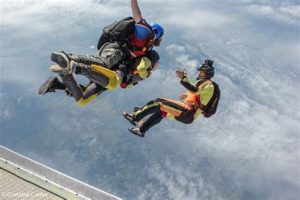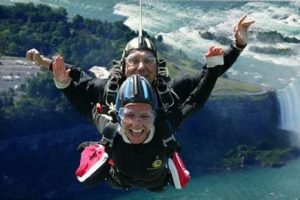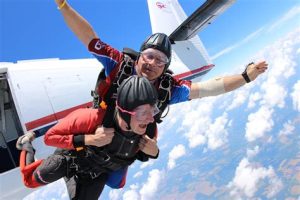Table of Contents
Discover the truth about tandem skydiving death rate. Are you considering this thrilling adventure? Learn the statistics and safety measures to make an informed decision. Understand the risks involved and how they are mitigated, ensuring your skydiving experience is as safe as possible.
Are you an adrenaline junkie looking for your next thrill? Tandem skydiving might be just the adventure you’re seeking. However, before you take the plunge, it’s essential to understand the risks involved. In this article, we will delve into the intriguing topic of the tandem skydiving death rate, shedding light on the statistics and factors that contribute to this ultimate sacrifice for thrill-seekers. So buckle up, and let’s explore the exhilarating world of tandem skydiving and its inherent dangers.
Introduction
Welcome to this article discussing the tandem skydiving death rate, an important aspect of the sport that often raises concerns among potential participants. While skydiving can be an exhilarating experience for thrill-seekers, it is essential to understand the safety measures and statistics associated with it. In this article, we will explore the death rate in tandem skydiving, providing information and insights to help you make an informed decision about this extreme activity.
Tandem Skydiving: An Overview
Tandem skydiving involves two individuals jumping from an aircraft, where a certified instructor is securely attached to a student or inexperienced jumper. This method allows beginners to experience the thrill of skydiving without having to undergo extensive training or acquire a license. The instructor takes care of all technical aspects, ensuring a safe and enjoyable jump for the student.
Safety Measures in Tandem Skydiving
Safety is of paramount importance in any skydiving operation. Certified tandem skydiving instructors undergo rigorous training and adhere to strict guidelines set by regulatory bodies such as the United States Parachute Association (USPA). They are well-versed in emergency procedures, equipment checks, and ensuring a smooth jump from start to finish.
The Death Rate in Tandem Skydiving
While the thought of a tandem skydiving death may be unsettling, it is crucial to put the statistics into perspective. According to the USPA, the fatality rate for tandem skydiving in the United States is approximately 0.003 per 1,000 jumps. This means that for every 1,000 tandem jumps, there is a 0.003% chance of a fatal accident occurring.
Comparing Skydiving to Other Activities
It’s important to consider the risk associated with other common activities when assessing the tandem skydiving death rate. For instance, according to the National Safety Council, the lifetime odds of dying from a motor vehicle accident are 1 in 103, while the odds of dying from a lightning strike are 1 in 138,849. Comparatively, the odds of dying from a tandem skydiving accident are significantly lower.
Factors Influencing Safety in Tandem Skydiving
Multiple factors contribute to the overall safety of tandem skydiving. These include proper training and certification of instructors, routine equipment maintenance, thorough pre-jump inspections, and adherence to weather-related safety protocols. By ensuring these factors are met, the risks associated with tandem skydiving can be minimized.
Risk Management and Incident Analysis
The skydiving community is committed to continuous improvement in safety practices. Incidents and accidents are thoroughly investigated to identify potential areas for improvement and prevent future accidents. This risk management approach helps maintain safety standards and ensures that appropriate measures are taken to mitigate any identified risks.
The Importance of Choosing a Reputable Skydiving Center
When considering a tandem skydive, it is crucial to choose a reputable skydiving center with a proven safety record. Researching the center’s certifications, reviews, and overall reputation can provide insight into their commitment to safety. Additionally, selecting an experienced instructor who follows proper procedures further enhances the overall safety of the jump.
Personal Responsibility and Decision-Making
Engaging in any extreme activity, including tandem skydiving, requires personal responsibility. Individuals must assess their own comfort levels, health conditions, and willingness to assume the inherent risks associated with the sport. Consulting with a healthcare professional, if necessary, can help determine whether tandem skydiving is suitable for an individual’s specific circumstances.
Conclusion
Tandem skydiving, while not without risks, maintains a relatively low death rate when compared to other activities. By understanding the safety measures in place, the commitment to risk management within the industry, and the importance of choosing a reputable skydiving center, individuals can make informed decisions about participating in this thrilling adventure. Remember, the joy and exhilaration experienced during a tandem skydive often outweigh the minimal risks involved.
Title: Tandem Skydiving Death Rate
Subtitle: Guidelines and Safety Precautions for Tandem Skydiving
Welcome to the guidelines and safety precautions for tandem skydiving. In this document, we will provide you with essential information regarding the death rate associated with tandem skydiving, which will help you make an informed decision before embarking on this exhilarating adventure.
1. Introduction
Welcome to the guidelines and safety precautions for tandem skydiving. In this document, we will provide you with essential information regarding the death rate associated with tandem skydiving, which will help you make an informed decision before embarking on this exhilarating adventure.
2. Understanding the Death Rate
It’s important to have a clear understanding of the death rate associated with tandem skydiving. While skydiving is an inherently risky activity, the death rate is relatively low compared to other extreme sports. This information will give you a sense of the overall safety record of tandem skydiving as an experience.
3. Statistical Analysis
According to the United States Parachute Association (USPA), the average annual fatality rate for tandem skydiving is approximately 0.003 per 1,000 jumps. This means that for every 1,000 tandem jumps performed, approximately 0.003 result in a fatality. Tandem skydiving, when undertaken with proper safety measures and precautions, remains a highly enjoyable and safe activity.
4. Contributing Factors
While the death rate is low, certain factors can contribute to accidents during tandem skydiving. Most commonly, accidents occur as a result of improper training or inadequate safety supervision, equipment malfunction, or unforeseen environmental conditions. It is critical to choose a reputable skydiving center with experienced instructors and well-maintained equipment to minimize potential risks.
5. Safety Precautions
To further decrease the risk of accidents, always ensure that you undergo proper training and familiarize yourself with the correct tandem skydiving techniques. Pay close attention during pre-flight instruction sessions and follow the instructor’s guidance rigorously. Prioritize your safety by ensuring your instructor is certified by a recognized association, such as the USPA, and that the skydiving facility adheres to strict safety protocols.
6. Equipment Inspection
Before you embark on a tandem skydiving experience, carefully inspect the equipment to ensure it is in excellent condition. Check the harness, reserve parachute, main parachute, and radio communication devices. Ensure all equipment is correctly fitted to you by a qualified instructor. If you observe any discrepancies or have concerns, promptly inform your instructor or the skydiving center staff.
7. Weather Conditions
Weather conditions play a vital role in tandem skydiving safety. Always check the weather forecast to ensure suitable jumping conditions. High winds, storms, or other adverse weather conditions can significantly increase the risk of accidents. Trust the judgment of your instructor to determine if a jump should be postponed or canceled due to inclement weather.
8. Conclusion
In conclusion, while tandem skydiving carries an inherent risk, the death rate associated with this activity remains relatively low when following strict safety guidelines. Choosing a reputable skydiving center, undergoing proper training, inspecting the equipment, and considering weather conditions are all essential steps to ensure a safe and enjoyable tandem skydiving experience. Remember, prioritizing safety is the key to an unforgettable adventure in the skies.
Thank you for your interest in tandem skydiving. We understand that safety is of utmost importance to you, and we appreciate the opportunity to provide information on the death rate associated with this thrilling adventure sport.
1. Tandem skydiving, like any other extreme activity, carries inherent risks. However, it is important to note that the death rate associated with tandem skydiving is relatively low.
2. According to various studies and statistical data, the mortality rate for tandem skydiving is estimated to be approximately 0.0003%. This means that out of every 100,000 jumps, only a few result in fatalities.
3. It is crucial to remember that tandem skydiving is a heavily regulated activity, with strict safety protocols in place. Professional skydiving centers adhere to rigorous training standards and maintain their equipment to ensure the highest level of safety for participants.
4. The majority of tandem skydiving accidents can be attributed to human error or unforeseen circumstances. While tragic, these incidents are rare and do not reflect the overall safety record of tandem skydiving as a whole.
5. To minimize risks, it is essential to choose a reputable skydiving center with experienced instructors who prioritize safety. These professionals undergo extensive training and follow internationally recognized guidelines to provide a safe and enjoyable experience for all participants.
6. Additionally, participants are required to complete a thorough pre-jump briefing where safety procedures, emergency protocols, and proper body positioning are explained. This briefing aims to reduce the likelihood of accidents and equip individuals with the knowledge needed to ensure a safe jump.
7. As with any adventure activity, it is vital for individuals to assess their own health and physical abilities before engaging in tandem skydiving. Skydiving centers typically have certain health requirements, such as a maximum weight limit, to ensure the safety of participants. It is important to disclose any medical conditions or concerns to the instructors before jumping.
8. While the death rate associated with tandem skydiving may seem concerning, it is crucial to keep in mind that skydiving centers continuously work to improve safety measures and reduce risks. Through ongoing training, equipment advancements, and strict adherence to regulations, the industry strives to maintain an excellent safety record.
In conclusion, while tandem skydiving does carry inherent risks, the death rate associated with this activity remains relatively low. By choosing a reputable skydiving center, following proper safety protocols, and maintaining good physical health, individuals can enjoy the thrill of tandem skydiving while minimizing the risks involved.
Thank you for taking the time to read our article on the tandem skydiving death rate. We understand that this topic can be quite alarming and may have raised some concerns or questions. Our goal with this article was to provide you with accurate information and help you make an informed decision about tandem skydiving. We want to stress that safety is of utmost importance in this thrilling sport, and we hope to address any fears or misconceptions you may have.
To begin, it is essential to understand that tandem skydiving has a remarkably low fatality rate. While accidents can happen in any activity, statistics show that tandem skydiving is relatively safe when compared to other recreational sports. In fact, according to the United States Parachute Association (USPA), the fatality rate for tandem skydiving is about one in every 500,000 jumps. This means that the chances of experiencing a fatal accident while tandem skydiving are incredibly slim.
It is crucial to note that the skydiving industry is heavily regulated to ensure the highest level of safety for participants. Skydiving centers must adhere to strict guidelines and regulations set by organizations such as the USPA, which continuously work to improve safety standards. These regulations cover every aspect of tandem skydiving, from equipment maintenance and training requirements to weather conditions and operational procedures. Additionally, all tandem skydiving instructors must undergo rigorous training and certification processes to ensure they have the necessary skills and experience to safely guide their students through the jump.
While the statistics and regulations provide reassurance, we understand that fear and uncertainty may still linger. It is natural to have concerns when considering an activity as daring as tandem skydiving. However, we encourage you to approach these concerns with an open mind and consider the countless positive experiences and life-changing moments that tandem skydiving has provided for millions of people worldwide. Ultimately, the decision to tandem skydive is a personal one, and we hope that this article has given you a well-rounded understanding of the sport’s safety measures and statistics.
Should you decide to embark on this exhilarating adventure, we recommend choosing a reputable skydiving center that prioritizes safety and has a proven track record. Always ask questions, seek information, and ensure that you feel comfortable and confident before taking the leap. Remember, tandem skydiving is an extraordinary opportunity to challenge yourself, overcome fears, and create memories that will last a lifetime. Embrace the adventure while knowing that your safety is paramount in the minds of the professionals who make this incredible experience possible.
Thank you once again for visiting our blog, and we hope that this article has provided you with valuable insights into the tandem skydiving death rate. If you have any further questions or if there is anything else we can assist you with, please do not hesitate to reach out. Stay safe and enjoy your future adventures!
.
Here are some common questions people also ask about the tandem skydiving death rate:
-
What is the death rate for tandem skydiving?
Tandem skydiving has an extremely low death rate. According to the United States Parachute Association (USPA), the fatality rate for tandem skydiving is approximately 0.003 fatalities per 1,000 jumps. This means that out of every 1,000 tandem jumps, only a very small fraction result in a fatality.
-
Is tandem skydiving safe?
Yes, tandem skydiving is considered to be safe when proper safety protocols are followed. The equipment used in tandem skydiving is regularly inspected and certified. Additionally, tandem instructors undergo extensive training and must meet specific qualifications before they are allowed to take passengers on tandem jumps. While there are inherent risks involved in any extreme sport, tandem skydiving is generally considered to be a relatively safe activity.
-
What are the main causes of tandem skydiving fatalities?
The main causes of tandem skydiving fatalities are usually related to human error or failure to follow proper procedures. These can include mistakes made during equipment checks, improper body position during freefall, or errors in parachute deployment. It is important to note that fatal accidents are rare in tandem skydiving, and the majority of jumps are completed without any incidents.
-
Can I reduce the risks of tandem skydiving?
While it is impossible to completely eliminate all risks associated with skydiving, there are steps you can take to minimize them. Choosing a reputable and experienced skydiving center with good safety records, following all instructions given by your tandem instructor, and ensuring that you are physically and mentally prepared for the jump can all help reduce the risks involved in tandem skydiving.
-
Are there any age or health restrictions for tandem skydiving?
Yes, there are typically age and health restrictions for tandem skydiving. The minimum age requirement varies by country and skydiving center, but it is usually around 18 years old. Additionally, individuals with certain medical conditions such as heart problems, epilepsy, or recent surgeries may be prohibited from participating in tandem skydiving. It is important to consult with your doctor and the skydiving center to ensure you meet the necessary requirements.






